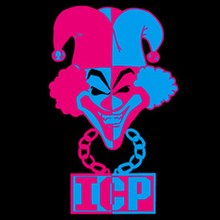Carnival of Carnage
| Carnival Of Carnage | ||||
|---|---|---|---|---|
 |
||||
| Studio album by Insane Clown Posse | ||||
| Released | October 18, 1992 | |||
| Recorded | 1991–1992 | |||
| Studio | Miller Midi Productions (Detroit, Michigan) The Tempermill Studio (Ferndale, Michigan) |
|||
| Genre | Horrorcore, midwest hip hop | |||
| Length | 66:17 | |||
| Label | Psychopathic Records | |||
| Producer | Joseph Bruce, Mike Clark, Esham, Chuck Miller | |||
| Insane Clown Posse chronology | ||||
|
||||
| Professional ratings | |
|---|---|
| Review scores | |
| Source | Rating |
| Allmusic | |
| Rolling Stone | |
| SputnikMusic | |
Carnival of Carnage is the debut album by American hip hop group Insane Clown Posse, released on October 18, 1992, by Psychopathic Records. It is the first Joker Card in the first deck. Recording sessions for the album took place from 1991 to 1992 at Miller Midi Productions and The Tempermill Studio. The album is the first Joker's Card in the group's Dark Carnival mythology. The album's lyrics describe the Carnival of Carnage as a representation of the violence that occurs within the ghettos, which takes the form of a traveling carnival to enact the same brutality on the upper class.
Carnival Of Carnage was the first album on which Insane Clown Posse collaborated with producer Mike E. Clark, who would work with the group throughout much of their career. It features guest appearances by popular Detroit rappers Esham and Kid Rock. The album features the only recorded appearances of member John Kickjazz, who left the group prior to the album's release. Although the album did not initially sell well, it became eligible for gold certification by the RIAA in 2010.
Joseph Bruce and Joseph Utsler formed a hip hop group in 1990. Under the stage names Violent J, 2 Dope, and John Kickjazz, the group began performing at local night clubs under the name of their gang, Inner City Posse. By late 1991, the group had invested more money into production than was covered by returns. They decided that their gangsta rap style was the cause of the problem: Most emcees at the time used similar styles, making it difficult for Inner City Posse to distinguish itself stylistically. Bruce suggested the band instead adapt a style similar to the hallucinatory, surrealistic "acid rap" of fellow Detroit rapper Esham, in a bid to have Detroit represent acid rap, much as Los Angeles represented gangsta rap. The group agreed, but not to copying the style of Esham closely. Instead, they suggested using horror-themed lyrics as an emotional outlet for all their negative life experiences. They were also unanimous in deciding not to rap openly about Satan, which Esham often did.
...
Wikipedia
